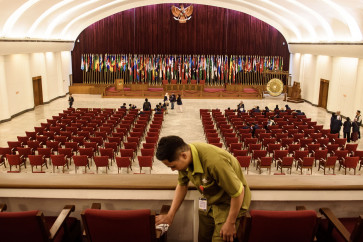Popular Reads
Top Results
Can't find what you're looking for?
View all search resultsPopular Reads
Top Results
Can't find what you're looking for?
View all search resultsMt. Timau observatory project reaches for stars
Mt
Change text size
Gift Premium Articles
to Anyone
Mt. Timau observatory
Indonesia is reaching for the stars with a new observatory construction project on Mount Timau in Kupang regency, East Nusa Tenggara, which is set to be the biggest observatory in Southeast Asia when it is completed next year.
For decades, Indonesian astronomy depended on the Bosscha Observatory in Lembang, West Java, which was built in 1928 by the Dutch and, at that time, had one of the largest telescopes in the southern hemisphere.
Bosscha, managed by the Bandung Institute of Technology (ITB) after the Dutch handed over the facility to Indonesia in 1951, has five main telescopes, including its iconic Zeiss double refractor, which is 60 centimeters in diameter and is found in the Bosscha dome.
But the need to build a new observatory has been growing in recent years, particularly since Bosscha continues to face excessive light and air pollution from its surrounds, making the environment for observation less ideal.
“To have a new observatory is urgent because the ongoing construction projects in Lembang and [the nearby city of] Bandung generate light pollution, which affects night sky observations [at Bosscha],” National Institute of Aeronautics and Space (LAPAN) head Thomas Djamaluddin told The Jakarta Post.
On July 9, LAPAN, in collaboration with the ITB, the only university that runs an astronomy program in the country, the Kupang administration and Nusa Cendana University (Undana), officially kicked off the construction project for the new observatory on the slopes of Mt. Timau, which is 1,300 meters above sea level.
The observatory will be equipped with a Ritchey-Chrétien advanced reflecting telescope measuring 3.8 m in diameter, which will be the largest in Southeast Asia after Thailand’s 2.4-m telescope that was built in Chiang Mai in 2013.
There are more than 60 modern reflecting telescopes sized 2 m in diameter and above at various observatories around the world. Only a few are located in the southern hemisphere and this, LAPAN said, would give Indonesia an advantage if it built one.
The idea to build a new observatory had been floating around since the 1980s and was reignited in the early 2000s.
But it was only about seven years ago when LAPAN and ITB astronomers began to scout for locations in the western and eastern parts of Indonesia to build the new observatory.
Its optimum performance depends on more than just skies that are clear of light and air pollution it also depends on temperature, wind and humidity, which made the search no easy task.
In their mission, they calculated clear sky occurrences in a year, the night sky brightness level and location accessibility.
LAPAN eventually found that Mt. Timau had a higher prevalence of photometric nights or clear night skies. It has an average of 250 clear night skies in a year, making it suitable for astronomical observations.
Located about 120 kilometers from Kupang city, the Mt. Timau observation area will unlikely be disrupted by pollution emitted by the biggest city in the province.
Another consideration is that it is located inside a protected forest area, and on a 47-hectare plot of land surrounded by a 330-ha buffer zone.
The observatory, which cost over Rp 300 billion (US$20.9 million) for its construction, will also feature a 50 cm survey telescope and a 30 cm solar telescope, which will be operated by a robotic system.
LAPAN is now pushing Undana to establish an astronomy academic program to support the Mt. Timau observatory.
“We expect that Mt. Timau will boost Indonesia’s science development and create tourism opportunities as well,” LAPAN spokesman Jasyanto said.
The site will feature a dark sky park and an ecotourism area that restricts artificial light pollution. It also aims to promote astronomy. The park will be located in the observatory’s buffer zone and LAPAN has considered installing dome-shaped thatched traditional houses as lodging.
“The Kupang administration and our people are in full support. We hope that it can be one of Kupang’s tourism icons in the future,” Kupang Regent Ayub Titu Eki said.










